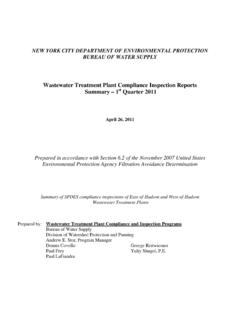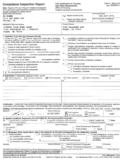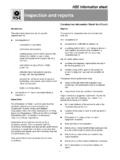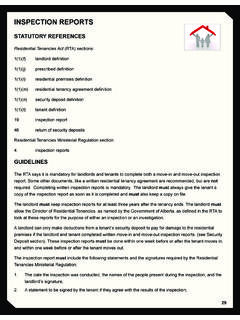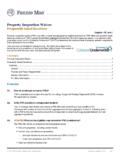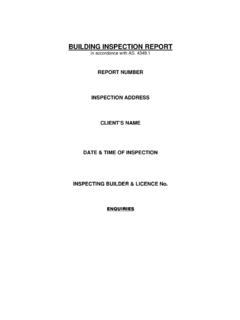Transcription of Classification and analysis of the GCP inspection …
1 01 December 2014 INS/GCP/46309/2012 Compliance and Inspections Classification and analysis of the GCP inspection findings of GCP inspections conducted at the request of the CHMP ( inspection reports to EMA 2000-2012) 30 Churchill Place Canary Wharf London E14 5EU United Kingdom An agency of the European Union Telephone +44 (0)20 3660 6000 Facsimile +44 (0)20 3660 5505 Send a question via our website European Medicines Agency, 2014. Reproduction is authorised provided the source is acknowledged. TABLE OF CONTENTS 1. GLOSSARY .. 3 2. INTRODUCTION .. 4 3. SCOPE AND AIMS .. 6 4. METHOD .. 6 INFORMATION ABOUT FINDINGS .. 6 INFORMATION ABOUT THE APPLICATIONS .. 7 INFORMATION ABOUT THE CLINICAL TRIAL(S) INSPECTED .. 8 INFORMATION ABOUT THE INSPECTIONS .. 8 INFORMATION ABOUT THE inspection OUTCOME .. 8 5.
2 RESULTS .. 8 OVERVIEW OF GCP INSPECTIONS REQUESTED BY THE CHMP AND CARRIED OUT BETWEEN 8 analysis OF THE FINDINGS .. 10 Findings by grading and category .. 10 Findings by type of site .. 13 Responsibility for the findings .. 15 Findings by area of inspections .. 19 6. CONCLUSIONS .. 33 7. ACKNOWLEDGMENTS .. 34 8. ANNEXES .. 34 ANNEX 1 - LIST OF CATEGORIES USED IN CORPORATE GCP DATABASE.. 34 ANNEX 2 - NUMBER OF FINDINGS BY MAIN CATEGORY .. 35 ANNEX 3 - RANKING OF TOTAL GCP FINDINGS .. 36 ANNEX 4 - TOTAL NUMBER OF FINDINGS BY CATEGORY AND GRADING AT INVESTIGATIONAL SITES .. 38 ANNEX 5 - RANKING OF FINDINGS AT INVESTIGATIONAL SITES .. 43 ANNEX 6 - TOTAL NUMBER OF FINDINGS BY CATEGORY AND GRADING AT SPONSOR SITES .. 45 ANNEX 7 - RANKING OF FINDINGS AT SPONSOR SITES .. 50 Classification and analysis of the GCP inspection findings of GCP inspections conducted at the request of the CHMP EMA/INS/GCP/46309/2012 Page 2/50 1.
3 Glossary BE/BA Bioequivalence/Bioavailability CAP Centrally Authorised Products CRO Contract Research Organisation CHMP Committee for Medicinal Products for Human Use CIS Commonwealth of Independent States CRF Case Report Form CSR Clinical Study Report EEA European Economic Area EFTA European Free Trade Association EMA European Medicines Agency EU European Union GCP Good Clinical Practice GCP IWG Good Clinical Practice Inspectors Working Group GMP Good Manufacturing Practice IEC Independent Ethics Committee/ IRB Institutional Research Board IC Informed Consent ICH International Conference Harmonization on Harmonisation of Technical Requirements for Registration of Pharmaceuticals for Human IMP Investigational Medicinal Product IR inspection Report MAA Marketing Authorisation Application MAH Marketing Authorisation Holder NCA National Competent Authority RA Regulatory Authority SAE Serious Adverse Event SOP Standard Operating Procedure UEC Under Exceptional Circumstances Classification and analysis of the GCP inspection findings of GCP inspections conducted at the request of the CHMP EMA/INS/GCP/46309/2012 Page 3/50 2.
4 Introduction Good clinical practice (GCP) is an international ethical and scientific quality standard for designing, recording and reporting trials that involve the participation of human subjects. Compliance with this standard provides public assurance that the rights, safety and well-being of trial subjects are protected, consistent with the principles that have their origin in the Declaration of Helsinki, and that the clinical trial data are credible. Clinical trials, conducted within the European Union, must comply with the requirements of Directive 2001/20/EC (herein after Clinical Trial Directive ) and Directive 2005/28/EC (herein after GCP Directive ). According to Directive 2001/83/EC all clinical trials included in marketing authorisation applications in the European Union, irrespective of their geographical location, are required to be conducted in accordance with the GCP and ethical principles equivalent to those of Directive 2001/20/EC.
5 Any clinical trial included in the application could be subject to inspection . Requirements for the conduct of clinical trials in accordance with good manufacturing practice (GMP) and inspections of these have been implemented in the GMP Directive for investigational medicinal products (IMP) for human use (Directive 2003/94/EC), the Clinical Trial Directive and the GCP Directive. Compliance by an applicant or marketing-authorisation holder (MAH) with GCP and the other provisions of a marketing authorisation for medicinal products for administration to humans will be assessed by the EU/EEA Inspectorates when the Committee for Medicinal Products for Human Use (CHMP) considers it necessary. The CHMP may request inspections in EU/EEA and also in third countries ( countries outside the EU/EEA). The inspections are usually requested during the initial review of a marketing authorisation application (MAA), but could be raised post-authorisation ( inspection of studies conducted or completed as part of the condition of a marketing authorisation, a new indication, a new pharmaceutical form or because of concerns arising from the studies previously submitted).
6 Different types of GCP inspections may be requested by the CHMP. The scope of these inspections may vary according to the objectives and the focus of the inspections. These inspections may be routine or may be triggered by issues arising during the validation of the pivotal clinical trials submitted to the European Medicines Agency (herein after the Agency ) or during the assessment of the dossier by the assessors or by other information such as previous inspection experience. A routine inspection is an inspection carried out as a routine surveillance of GCP compliance in the absence of specific trigger elements. A triggered inspection is an inspection requested because there is a concern due to either the actual issues observed or the potential impact of deviations from GCP on the conduct of the study as a whole or at a particular site.
7 In general, the CHMP request for a GCP inspection is focused on the most important trials involved in the application. The objectives of a GCP inspection requested by the CHMP are: to determine whether the trial was conducted in accordance with applicable regulatory requirements which include local regulations and ethical standards, and the CPMP/ICH/135/95 Note for Guidance on GCP (ICH-GCP), Directive 2001/83/EC as amended and Directive 2001/20/EC; Classification and analysis of the GCP inspection findings of GCP inspections conducted at the request of the CHMP EMA/INS/GCP/46309/2012 Page 4/50 to provide answers to questions arising from the assessment process; to determine whether the data submitted in the dossier are credible and accurate. Articles 2 and 15 of Directive 2001/20/EC further specify the locations where inspections shall be carried out in order to verify compliance with GCP standards.
8 The sites concerned by a clinical trial include particularly, but not exclusively, the investigational site or sites, any laboratory used for analyses in the clinical trial, contract research organisation s and/or the sponsor s systems and premises. The findings or failures to comply with GCP are presented formally to the representatives of the inspected entity and the sponsor/applicant of the trial in the inspection report (IR). Any response from the inspected entity and the sponsor is considered and the process is completed with the issuing of the IR and its addenda to the Agency. If the outcome of the inspection is negative (GCP non-compliance and/or invalid data), the CHMP can take any necessary regulatory action, which may involve the refusal to authorise the product or the indication submitted, etc. At the Agency, an important part of the work of the Clinical and Non-Clinical Compliance service involves harmonisation and coordination of GCP-related activity at EU level.
9 This service is involved in coordinating GCP inspections for the centralised procedure for a MAA. The GCP inspectors working group (GCP IWG) has developed procedures for the coordination, preparation, conduct and reporting of GCP inspections carried out in the context of the centralised procedure. Through the work of the GCP IWG the service is involved in the preparation and revision of guidance on GCP topics, coordination of advice on the interpretation of EU GCP requirements and related technical issues. Between 2000 and 2012, a total of 398 GCP inspections of centralised products requested by the CHMP were conducted. These GCP inspections included investigator sites, sponsors, contract research organisations (CROs), and a few other types of sites including clinical laboratories and facilities dedicated to bioequivalence/bioavailability (BE/BA) studies.
10 In the inspection report each finding makes reference to the ICH-GCP guideline or other rules to which the non-compliance identified relates. However, this system is not practical to use for analysis from a statistical point of view, because the ICH-GCP guideline often refers to a particular aspect of GCP in more than one place. Therefore, a finding can refer to several points in the ICH-GCP guideline. The difficulty for analysis could be overcome by structuring the system using categories, so that one finding belongs to one single category. The GCP IWG agreed with a Classification of 50 categories included in 11 main categories (annex 1). While providing less fine detail than an analysis based on each point of the GCP guideline, this system gives sufficient detail to provide a profound basis for an analysis . The Agency decided to carry out a work project to classify the findings of all of these GCP inspection reports and provide a platform for categorisation of future IRs.










